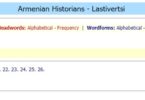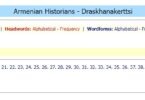Vartanantz Day Speech
Tom Samuelian
St. Mesrop Church
Racine, WI (1988)
Events don’t take place in isolation, nor do their consequences evaporate with time. There are conditions which lead up to an historical event and there are changes which occur as a result of it.
Vartanants is so well know, so over-worked in many ways, that it is sometimes difficult to image that there is anything new to say about it. Along with Sts. Gregory, Mesrop and Sahag, St. Vartan among our best-known national saints. While piety is called for when mentioning so venerable a figure, before we begin, I would like to put our commemoration itself into context. One can tell when a figure has become a venerable institution when the very act of veneration has become institutionalized. I think this is what the 19th-century Armenia satirist Hagop Baronian had in mind when he wrote:
Tomorrow in all our schools, speeches will be given on the occasion of Vartanants. After the speeches are given a tragedy feature Brave Vartan will be presented. Every school has for itself a separate tragedy: you will see in one that Vartan dies in the war, in another that he drowns in the Tghmut river and in yet another that he dies after he returns from the war. In the end, everyone Kills Brave Vartan as he likes. Come see that Brave Vartan will show is bravery in this tragedy as well. He will kill the greater part of the tragedians who are killing him. So tomorrow Brave Vartan will make war not only against the Persians, but also against our tragedians, and I am certain that Vartan will carry the victory.
During today’s talk St. Vartan will be above the fray, for aside from recalling the fact of his leadership and demise, I will have little to say about him. Instead, I would like to talk about us, those who have inherited the honorable responsibility for commemorating this saint. But first the facts:
On May 27, 451, (the date is of course interesting in itself, for roughly 1450 years later on nearly the same day the Armenian Republic declared independence). Everything, it seems, is related in one way or another. In any case, on May 27, 451, there was a battle in the town of Avarayr located on the Tghmut River, which is about 50 miles east of Van, in northern Iran today, just across the Soviet Armenian border. Armenia at the time was a loose confederation led by a council of nakharars, representing various princely families, among whom there was a division of labor. The Mamikonian family traditionally served as head of the Armenian armed forces. The leader at this time was Vartan, who by virtue of being from the Mamikonian family, held the title of Sparapet, or military commander of the Armenian forces. Vartan, by the way, was, as we might say today, well-connected. St. Sahak was his grandfather, St. Gregory a great uncle, several times removed. On that spring day, May 27, 451, the Armenians were fighting the Persians–we’ll come back to why later.
They were outnumbered, and Vartan and 1036 soldiers perished in defense of their national and religious identity. Thereupon, several clergymen and 35 princes were taken hostage by the Persians. In a related incident several years later, the priest Ghevond was martyred. As a consequence of these events, there are Armenian churches around the world name Srpots Vartanants and Srpotz Ghevondiants, and major feasts are observed each year the week before Lent in honor of these martyrs of the Armenian Christian faith.
Simply saying that they perished in defense of Christianity at a decisive time in Armenian history accounts in part for our gathering today. Without being strongly deterministic in our understanding of history and daily life, one can say that most of us are here today simply because our parents and theirs before them, for about 35 or 40 generations did the same, and because some ancestor of ours, who lived in some part of Armenia in St. Vartan’s time, probably didn’t take part in the battle, but as a consequence of the battle remained alive as an Armenian and perhaps as a Christian. Christianity was only slowly taking hold in the country. Armenia was divided at the time, the larger half under Persian rule. In the Persian part of Armenia, Zoroastrianism had been practiced for centuries and was the official religion of the Persian overlords of Armenia at the time. The oppression of the Persian regime at the time was the immediate cause of the rebellion. And the Armenians’ national religious freedom and identity was what was at stake. Somehow out of this defeat, the Armenians of that time and since have found inspiration to continue being Armenian Christians.
We today have inherited the right and obligation to hold a commemoration such as this as a result of our ties, both physical and cultural, to those Armenians some 1500 years ago. Thus, the act of commemorating or even feeling the need to commemorate these martyrs constitutes an act of being both Christian and Armenian. After all those who are not Armenians and are not Christians usually do not feel a duty to do so. A few moments ago, I said that St. Vartan and the 1036 died at a decisive time in history, but all times are in fact decisive and every sacrifice, large or small, made as an act of conscious is decisive. Your act of interrupting your daily routine to be here and remember is in this sense both decisive and historic. A unique event in time, which would not have taken place if a community had not decided it would take place. And this unique and decisive event would not have taken place if that unique and decisive event had not taken place some 1500 years ago.
At this point you might ask what the Armenians were fighting about anyway. To understand this, we have to go back at least 80 years earlier to 387, though a fuller answer might take us back to 550 BC. In 550 BC the Armenians had become part of the Persian Empire of Cyrus and Darius. In fact, one of first times Armenia as such is mentioned is on a monument, the Behistun stone, commemorating the annexation of Armenia by Darius. During the next 1000 years, the Armenians were directly or indirectly under Persian influence. During this time, many words of Persian origin entered the Armenian language, such as jamanag, gaboyd, naw, hreshdag, mah, ashkharh, and hundreds of other everyday Armenian words come from Persian. Persian princely families ruled Armenia. The Arshakunis, for instance, were the rules in the early years of the 5th century. Armenian internal politics was, therefore, intimately tied to the politics of the Parthian and later Sasanian kingdoms. In 227 AD, the Arshakuni line died out in Persia, but it continued to rule in Armenia until 428. It is not surprising therefore that there would be tension between the Armenian Arshakunis and their Sasanian successors in Persia.
The Persian political theater was of course only one part of the picture. On the other hand, the Greeks, our brothers in Christ, had their own political and theological aims and interests. Armenia happened to be the border land between the two large empires of the day, Byzantium and Persia, and so it served as a buffer state, a bone of contention, divided eventually in 387 AD.
In 387, the year St. Vartan Mamikonian was born, Armenia was partitioned between the Byzantine Greeks and the Sasanian Persians. Interestingly, Yeznik Koghbatsi, one of our earliest philosopher-theologians was born that same year and waged much the same battle with the pen that Vartan did with the sword. The Armenian thus divided were unsure where to turn. The country was in disarray. The king was unable to maintain order, being undermined by the local princes who were being played off against one another by the two empires. Eventually the Armenian king, Arstashes IV was deposed at the urging of the Armenian princes in 428 as was Sahak Catholicos. It was from the midst of this turmoil that St. Vartan emerged to lead a small force into unequal battle. Probably what was amazing at the time was not the loss, which must have been expected given the military disbalance, but the simple effort. It must have been revitalizing and refreshing to see that in the midst of this internal chaos, it was still possible for a leader to emerge and for people to follow and fight for what they believed was right.
So, what we have is a military defeat but a moral victory. Much can be said about a people who have transformed a moral victory into a defining event in their history. Let us reflect a moment on what it takes to make a moral victory into a point of pride. A certain disregard for reality in deference to devotion to an ideal. A certain sense of “well, yes, we lost the battle, but we won the war.” A certain reverence for persistence and stubbornness. A certain pride in being the underdog. A certain irreverence for what’s considered “sensible or reasonable or practical.” A certain sense that what they are doing it right and worth just about any cost. Perhaps a certain sense of powerlessness or desperation, which make bravado verging on recklessness appealing. A certain kind of quixotic or romantic willingness to sacrifice almost everything for the cause. Some might call it pluck, others hubris, others self-delusion. Without going much further, I would propose that we reflect on our situation today and ask ourselves to what extent the moral victory of Vartanants sheds light on Armenian life and character through the ages, down to our present day.
I hope that I have show today that events have significance beyond the present, that we ourselves and our actions have significance beyond the moment, through our connections with institutions and groups larger than ourselves in time and place; that for this reason it is important to commemorate and reflect upon our past and what it has made us “us”; that history is an extension of our own autobiography; that in order to understand the significance of an event it is necessary to bring the full range of experience and knowledge we have to bear on it; that the significance of an event is a function of our ability to give it significance, and that the burden for making sense of ourselves and our institutions rest upon our own shoulders. This goes not only for the past, but more especially for current events, events happening in our own lifetimes. This is another, often overlooked, though perhaps no less important, lesson of Sts. Vartanants, a sense of time, risks and possibilities.







